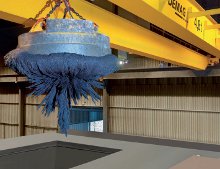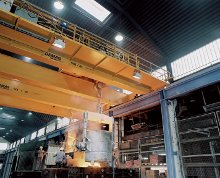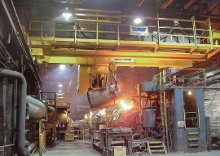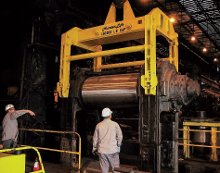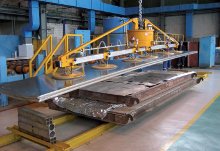Lifting the industry
16 October 2013Some of the biggest and most robust equipment is needed for iron and steel making. And despite economic problems demand is holding up.
Steel is a basic industry, at the heart of modern civilisation and production of consumer goods, cars, ships and trains, high-rise buildings and bridges in steel frame or reinforced concrete. Huge quantities are made across the world and more and more in the developing countries.
There is also a lot of lifting to do around steel furnaces, forges and foundries, demanding multiple lifts to move extremely heavy and sometimes red hot loads. For many hoist and cranemakers therefore it is an important, if demanding, market.
The suppliers into the industry fall into two main categories; those who make the overhead cranes, and other lifting mechanisms, as well as complete systems, and those who concentrate on the "under the hook" devices and gadgets. These have their own special features in steel work and a wide range is made from orange peel grabs to handle scrap and raw materials, to specialised slab handlers, coil lifters and ingot clamps. Other devices are required too for lifting out parts of the production lines and roller mills for maintenance and replacement.
The big names in crane and hoist making are of course represented. For the overhead cranes and lifting hoist equipments Germany's Demag, owned by Terex is a key playing and so is Finland's Konecranes with worldwide operations via divisions in Europe, the US and Asia. In America major names include Draftco, Whiting and Virginia Cranes in the south.
Continuous service
For all of these some of the biggest and heaviest units need to be supplied. Most of these are what Virginia Cranes describes on its website as Class E and F, for severe and continuous severe service, lifting heavy loads on a nearly continuous basis to keep often 24 hour production lines running without a break. Cranes have to work close to furnaces where temperatures reach 1400 degrees and loads which, while not at those temperatures are still extremely hot.
This kind of equipment is not supplied "of-the-peg" but is customised for particular factory installations, not to say specifically designed as part of an overall engineered solution for a production process.
For example Demag says that its "process cranes are tailored to meet the needs of customers' production processes. They are designed and built to specific requirements. In this way, we ensure the highest efficiency, availability and safety for the installations of our customers. We have extensive expertise and knowledge of our customers' specific industrial processes."
Casting construction
Recent orders for the Terex Materials Handling division include overhead units for handling scrap iron work in Sweden and for a custom rolled precision strop steel mill in the US. Another metals handling order is for titanium processing in Saudi Arabia.
The scrap steel order goes to Swedish iron foundry Arvika Gjuteri which is installing a new Demag process crane with an integrated weighing and position measuring system. The firm makes castings for commercial and off-road vehicles and wanted to increase handling rates for scrap to march increased production capacities.
"Speed and precision are decisive factors when collecting the material" says Anders Nilsson, Arvika project manager. "While the old crane needed up to 60 minutes for a single operating cycle, the new crane manages this work in only 12 minutes."
The speed increase from the Demag ZKKW double-girder process crane allows reduction of 24 hour working to two shifts in the charge make-up area where scrap is prepared and sorted for transfer to an induction smelting furnace.
Orders have to be mixed correctly which is aided by calibrated crane scales integrated in the open winch cab. Date transmitted to the cab by radio and displayed there. The more precisely the respective mixture is produced by the crane, the fewer high-cost alloys are required.
In the US the Feroleto Steel Company, party of wholly owned Toyota Tsusho American, has recently bought a new factory facility for precision strip steel production used in automotive, electrical and appliance industries. This is being customised for its work including enhancement of the overhead material handling; the facility needed electrification, runway re-engineering and an overhead crane. Feroleto chose Terex's Demag-branded cranes and worked with Terex Material Handling to tailor the product for the manufacturing process. Important aspects were durability to handle train loads of coil at a time. The solution adds a double-girder, 30 ton Demag crane.
Ferolto general manager Glenn Valentine, says the company chose the unit for safety, quality and reliability." For Konecranes the steel sector is important says marketing manager Heikki Lappalainen at the Finland headquarters.
"It is a global business and so is Konecranes so we are able to service customers on all the main continents."
Material handling
A range of material handling equipment goes into the steel sector from Kone he says starting from chain hoists and ending with high capacity raw material handling as well as hot metal handling cranes.
"Our range includes chain hoist, jib cranes, light and high duty cranes, lift trucks and reach stackers, grab unloaders and service products related to the material handling equipment maintenance and machine tools," says Lappalainen.
He says the continuous nature of the steel production process and its scale demands availability, safety and user friendliness from the equipment supplied.
"Automation levels are increasing too, not simply in the materials handling equipment supplied but also its integration into the overall process." For this reason he says it is important to be aware of the customers process and to work with them cooperatively to ensure understanding.
One of the biggest of the US makers is the Whiting Corporation Draftco based in Illinois near Chicago and the industrial areas near the lakes.
"We build the overhead cranes for steel handling and production, essentially anything running on rails" says crane product group supervisor Alan Horgan. "But we don't do the handling devices at the end of the hooks; those come from various suppliers like Bradley or Caldwell."
The units are supplied primarily to the American market including most of the major US companies in steelmaking he says, although there are some exports to the rest of the world.
It has been a fairly busy sector in recent years he says for a variety of reasons. One is simply the industrial boost given by federal financial intervention after the crisis period of 2007-8. But there has also been a natural renewal going on he thinks.
"Steel saw a lot of investment in the 1960s and 1970s but has then concentrated on output rather than new investment. But quite a lot of the industry has reached the point where it needs to renew and upgrade the capital plant so there has been a number of orders for that reason.
Fracking future
But another influence has been the growth of the new gas and oil fracking technology which has had a major impact on the heavy end of industry from two directions. Firstly the reduced energy costs and higher energy security within the US have encouraged a return of raw materials to the country. Secondly the fracking exploration and gas distribution has been s significant factor in increased demand itself, for underground and above ground distribution pipework, mostly made from steel.
Whatever the reasons the company has seen a significant level of orders for its equipment which has a reputation for reliability and maintainability he says. "This is an industry where continuous production matters and downtime is costly so customers look for those aspects."
Virginia Crane is another maker of big overhead units which has sold significantly into the steel industry in recent years particularly with investments from European- or Asian-owned companies for new steel capacity being built in the south of the US.
The company makes overhead bridge and gantry cranes, for most of the operations in steel making such as slab handling with capacities ranging from 20 tonnes up to 120 tonnes recently but higher if needed.
For many of the installed cranes the specific task it undertakes requires specialised lifting attachments to deal with coils, slabs ingots and fragmentary products like steel fibres or scrap.
Lift devices are wide ranging and use technologies from magnets to vacuum lifters as well as scissor grips and tongs, large C-hooks to pick up coils and orange-peel grabs. Powered rotating units are important, controlled by radio more and more and units that gather information on the load, particularly weight, are also more and more the requirement.
Weighing functions are significant for supplier Draftco for example which says that its weight capacity equipment in its under the hook products is now certified within the US to NTEP standards, which means to an accuracy of 0.1%.
"That is accurate enough to make the registered weight legal for trade and sale purposes" says company president Bruce Wesley "which is important."
Capacity creation
The company makes a full range of steel handling attachments from ladle beams for pouring molten metal to coil lifters, slab lifters and tongs, wet tongs for quenching operations, and a range of coil handling devices.
Capacities range up to 190r "though we have never run into anything we could not handle" says Wesley. "Most of our equipment is custom designed as part of an installation so we would modify it as needed.
Keeping operations remote and away from the operators has become more and more important he says. Most of the equipment is powered and nowadays primarily operated by radio units.
Another name in under-the-hook devices is Hunter Lift, again offering equipment for slabs, ingots, coils and tipping beams. "We have motorised grabs, sheet steel lifters to handle stacks of sheet and tongs for big slabs up to 200t.
Everything is customised says Tim Brookbank marketing manager for the firm which is based in Ohio. His firm also makes lifters for lifting out the rollers on the sheet making mills when they require maintenance.
The Caldwell Group is another of the major suppliers for under-the-hook equipment again with a wide range of products for the production lines from grabs to coil handling equipment. The company also does magnetic and vacuum lifters for steel sheet.
Billets, slabs, plate and coil handling are the territory too for Bradley Lifting, a long established firm in the American market and now part of the Xtec group, "though we continue our operations much as we did before 2007" says sales engineer Scott Salisbury. Xtec's philosophy is the American mantra of "if it ain't broke, don't fix it".
The company custom designs its products either in conjunction with the overheard crane maker or the designer for the end-users production facility. "These are big pieces of equipment handling in the plus100t range sometimes and at high temperatures". Most of the grabs and lifters are powered for rotation he says and are controlled usually by radio signals "from the operators cab on the crane or sometimes from "belly boxes".
The emphasis on safety has increased years by year he says "and it is aspect of our thinking, keeping people out of the way of the dangerous situations." Load position sensors and displays are more and more used, with a progress towards much more automation.
Bradley sells primarily in the US, says Salisbury, but in recent years has made significant sales internationally. Like others, he reports some good movement in the market which has been "freeing up. We have seen quite a lot of new projects and improvements in existing operations."
Vacuum variety
In Europe meanwhile there are a number of suppliers for under the hooks equipment. In Germany Schmalz specialises in vacuum lifters for sheet steel, used mostly for handling after the production in distribution yards and stockholders.
Volker Schnell director of international sales says that the advantage of the equipment is fast recycling times for lifting. Units come in a variety of sizes.
One recent product has been tailored for operation with a laser cutter in this case the Trumpf TruLaser 1030. The installation, for a specialist stainless steel product maker, the Hohmann company, comprises a VacuMaster Basic vacuum lifting device, chain hoist and column-mounted jib crane.
Vacuum lifters are also offered by UK firm Anglia Handling. According to sales director the Vaculift range offered by his firm, also made in Germany, has the advantage of a non-powered vacuum creation. Instead the vacuum is induced by the hoist lifting action which operates on a cylinder. The vacuum is automatically released when the load is dropped again. Loads up to 4t can be lifted.
Anglia also distributes the under-the-hook products of Spanish manufacturer which range widely from assorted grabs and clamshells, including orange peel grabs for handling scrap iron, to tongs, clamps and grips for slabs, sheets, ingots, bars and pipe.
Finally in this sector there are a number of specialist products. One is contour hardened crane wheels from Xtec, manufactured both in Europe and in the States. The wheels in a range of sizes are hardened on the circumference and in the "throat" between the flanges by a proprietary hardening system that the company claims will give a life span of up to three times that of a normal wheel.
Wheel integration
According to an Xtec spokesman, the hardening also means the wheel retains its shape for much longer and this reduces wear on rails. The crane wheels are usually specified at the point of replacement when the first set has worn says the company, and then "very rarely do users revert to other types because the maintenance and cost advantages are very clear, despite a somewhat higher purchase cost for the wheels."
Xtec makes rolling wheels for heavy cranes but also sheave wheels for the hosting or crane lifting mechanism. For this function there are additional advantages. Wheel grooving caused by wear from the cables is much reduced; grooving can cause ropes to sit badly on the wheel and also reduces the operating diameter of a sheave wheel with knock-on effects.
Finally there is the rail itself, appropriately enough a product of the rolling mills and foundries that the rest of the equipment is being used in.
A major producer exporting these all over the world is the Indian-owned Tata Steel at one of the former British Steel works in the UK.
Product marketing manager Dave Watson says that the crane rail is different to normal rail produced for trains and metros because the cranes used on it travel much more slowly and infrequently, but put much higher load demands on the rail.
The A range of rail produced by the firm comes in sizes of 65mm to 150mm and is made to German DIN standards. Much is used for ports and harbours, but factories and foundries are important customers too he says. The rail is often specified by a design engineer for a factory facility working with specifications from the manufacturer of the cranes installed.
